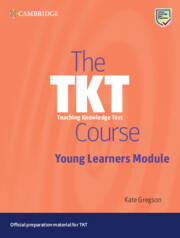Book contents
- Frontmatter
- Acknowledgements
- Contents
- Introduction
- Part 1 Knowledge of young learners and principles of teaching English to young learners
- Part 2 Planning and preparing young learner lessons
- Part 3 Teaching young learners
- Part 4 Assessing young learner learning in the classroom
- Follow-up activities: Answer keys and commentaries
- List of terms found in the TKT Glossary
- Glossary of TKT: Young Learners terms
- Test tips for TKT: Young Learners
- Teaching knowledge test young learners: Practice test
- Sample test answer sheet for TKT: YL practice test
- Answer key for TKT: YL practice test
Unit 9 - Classroom activities for language practice: How can I use practice activities to consolidate children’s language learning?
Published online by Cambridge University Press: 14 March 2024
- Frontmatter
- Acknowledgements
- Contents
- Introduction
- Part 1 Knowledge of young learners and principles of teaching English to young learners
- Part 2 Planning and preparing young learner lessons
- Part 3 Teaching young learners
- Part 4 Assessing young learner learning in the classroom
- Follow-up activities: Answer keys and commentaries
- List of terms found in the TKT Glossary
- Glossary of TKT: Young Learners terms
- Test tips for TKT: Young Learners
- Teaching knowledge test young learners: Practice test
- Sample test answer sheet for TKT: YL practice test
- Answer key for TKT: YL practice test
Summary
LEARNING OUTCOMES
By the end of this unit, you will…
KNOWLEDGE: know about the importance of practice activities in language learning
SKILLS: be able to identify demands and appropriate support for learners when using different language practice activities
■ Starter Question
Before you begin this unit, read the starter question and make some notes. Then read the commentary and compare it to your notes.
Why are language practice activities an important element a language lesson? Note two or three reasons.
COMMENTARY
What is a practice activity?
Simply put, a practice activity is one where learners use the skills and language that are being focused on in the lesson (or series of lessons). This language is often known as target language and may be a grammatical structure, vocabulary items, set phrases, functional language or chunks. The practice may be spoken or written if it is productive, or it may involve listening or reading if it is receptive; it may focus on subskills of these skills.
Why practise?
It seems clear that in order to learn to speak a language, we should use it – consider the expression, ‘Practice makes perfect’. However, in some teaching and learning contexts, language is seen as a subject to study, rather than something we learn to use. In such a situation, learners may practise only rarely and as a result, at the end of their studies they may know a lot about language, but are often less able to use the language in communication with another speaker of that language.
Constructivist learning theories tell us that learners need to be active in the learning process – they are not passive receivers of knowledge, but actively build their understanding of concepts and language. Meanwhile, behaviourist views say we learn from mimicking and memorising language. Interactionists, on the other hand, suggest we learn through communicating and negotiating meaning with others (see Lightbown&Spada, 2021, especially Chapters 4 and 6, for an in-depth look at second language learning theories). While some of these and other theories are more influential than others in modern thinking, we can clearly see the importance for learners to have the opportunity to actually practise using the language, trying it out and getting used to it.
- Type
- Chapter
- Information
- The TKT Course Young Learners Module , pp. 91 - 102Publisher: Cambridge University PressPrint publication year: 2024



